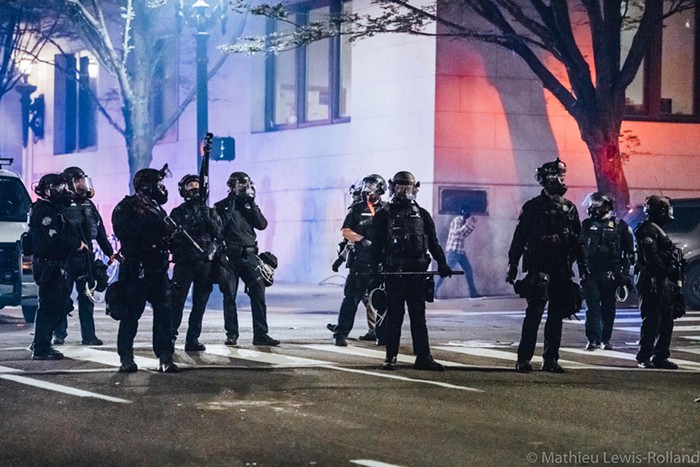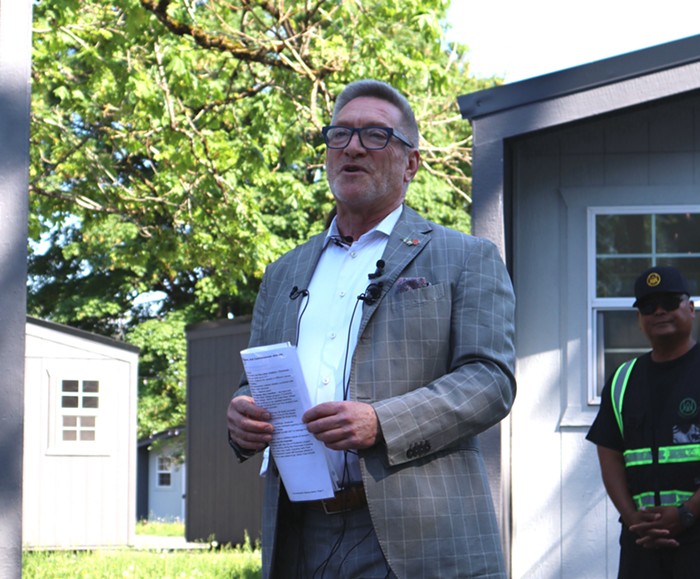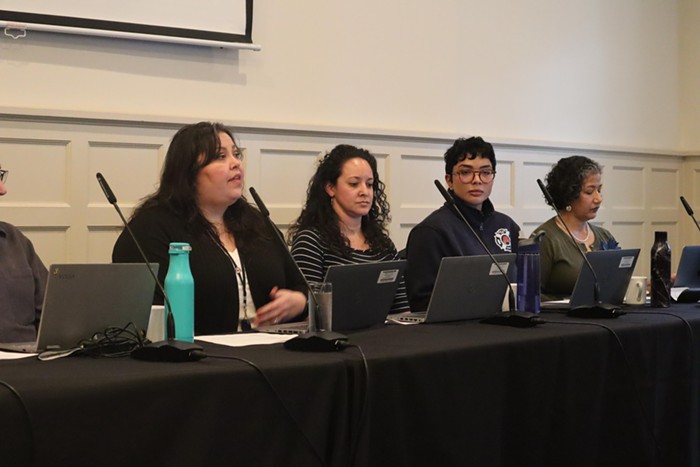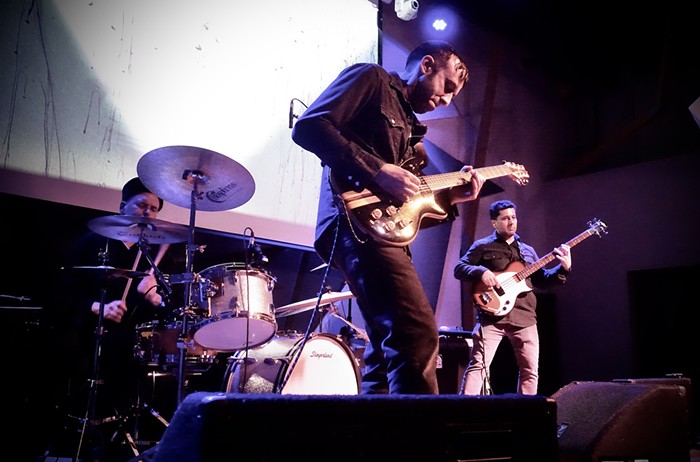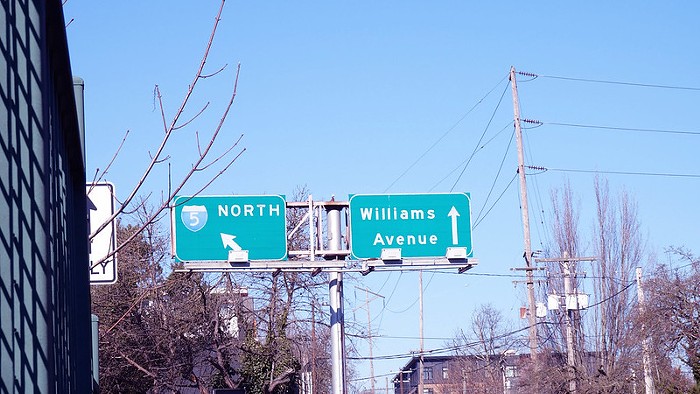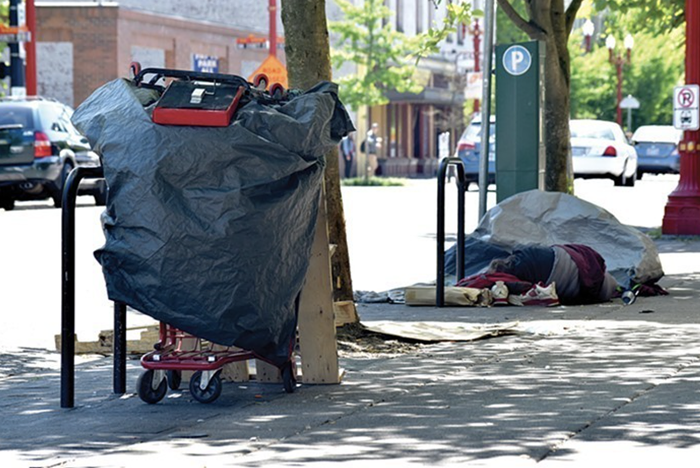With the city’s gun violence rate still hitting historic highs, Portlanders are looking for new ways to crack down on shooters. The latest suggestion comes from a new volunteer-led police oversight group, which meets weekly to analyze the previous week’s shootings with officers from the police bureau’s gun violence prevention unit, the Focused Intervention Team (FIT).
After months of discussion and research, the group of eight is preparing to send a recommendation to Portland City Council to introduce the controversial gunshot-detecting technology, ShotSpotter, to Portland.
“Our police force as it is structured right now can’t keep up,” said Ed Williams, the chair of the community group, dubbed FIT COG (Focused Intervention Team Community Oversight Group), during a May 5 meeting. “If we think we’re going to attack this problem by doing the same things we’re already doing, we’re fooling ourselves.”
ShotSpotter technology relies on AI to sense and document noises captured on small microphones, often attached to telephone poles or light posts, that sound like a gunshot. Within a minute of sensing a gunshot-like noise, ShotSpotter sends the general location of that sound (the company boasts accuracy of within 82 feet) to local police. The company measures its success by its program’s ability to alert police to a shooting without receiving a 911 call about it, which could come long after the shots are fired, if at all.
The program isn’t necessarily novel: The California-based company began installing its hidden microphones in cities in the late 1990s, and now more than one hundred US cities employ the technology.
The FIT COG first introduced this idea after the city paid for Williams and FIT COG vice chair Kimberly Dixon to travel with FIT officers to an April training in Florida focused on a program called Project Safe Neighborhoods, a federally-funded program that uses a model called “focused deterrence” to reduce gun violence. ShotSpotter is a crucial piece to that model, and was lauded during the training by members of Tampa Police Department, who use the technology.
"If we think we’re going to attack this problem by doing the same things we’re already doing, we’re fooling ourselves."— Ed Williams, FIT COG chair
In the first FIT COG meeting after the visit, Dixon spoke about the decrease in gun violence Tampa has seen following ShotSpotter’s rollout and how, according to Tampa police, the public has embraced the program. Dixon urged the volunteer group to throw their support behind the technology.
“We must move with urgency,” said Dixon, pointing to the shootings that took place in Portland while they were away. “I did not go to Florida for a vacation. I saw things that could be really helpful for us.”
Yet, the technology’s rollout across the country hasn’t been without controversy. ShotSpotter’s model has been criticized for its ability to pick up and record human voices, raising concerns that it could be misused by law enforcement for surveillance. It’s also easy for the technology to falsely identify a noise as a gunshot (often, the sound of a firework, a jackhammer, a truck door slamming, or another loud noise can trigger the sensor). A 2021 report by Chicago’s inspector general found that in a 16-month period, only 9 percent of ShotSpotter alerts in Chicago sent police to a scene of a gun-related criminal offense. This statistic not only raised criticisms for wasting officers’ time, but it drew concern about officers on high alert barreling into neighborhoods prepared to encounter a shooter. The Chicago report also saw an uptick in people being stopped, questioned, and frisked by officers if they were in an area where a gunshot was allegedly recorded, even if they had no connection to a crime. And more often than not, cities focus their ShotSpotter sensors in neighborhoods that are home to residents of color, inevitably increasing interactions between police and people of color.
Public scrutiny of the program surged in early 2021, when it was discovered that ShotSpotter summoned police officers to the Chicago neighborhood of Little Village, where an officer fatally shot 13-year-old Adam Toledo. Toledo had been walking with a man who fired a gun, and Toledo picked up the weapon afterward. He was shot by police after following officers’ orders to drop the gun.
The technology has also been used to incarcerate innocent people. In August 2021, a 65-year old man named Michael Williams was falsely accused of murder in Chicago with the sole evidence being audio of a loud bang picked up by ShotSpotter microphones. After a year behind bars, his case was dismissed for lacking sufficient evidence. A subsequent investigation by the Associated Press found that forensic reports prepared by ShotSpotter analysts have been used in court to falsely claim that someone shot at police or wrongly calculated the number of shots fired during a specific incident.
Some members of the public have raised these concerns with FIT COG members during the group’s weekly meetings, pushing members to defend the program’s rocky past.
But for members of the FIT COG, ShotSpotter’s benefits outweigh its potential downsides in the midst of a record-setting gun violence epidemic.
In a draft recommendation that FIT COG intends on presenting to city council in the coming months, the group will claim that ShotSpotter can aid in “increased notification and response time to shots fired,” “increased access to ballistics and crime scene evidence,” and the ability to “solve cases faster,” among others. The group is united in its mission to act with urgency.
“I’d rather take an action and have to correct that action than do nothing,” said Williams at a June FIT COG meeting.
The program has the tentative support of FIT officers, who assert the data-driven program will eliminate the public’s long-held worry that the police bureau’s gun violence prevention team disproportionately targets people of color. FIT leader Sergeant Ken Duilio sees ShotSpotter as a way to rebuild community trust.
“I think we need to find a way that’s acceptable that doesn’t look like the police are targeting people, [or] focusing on minorities but actually serving the community to save lives,” said Duilio in a June FIT COG meeting.
Duilio was part of the police bureau’s previous two iterations of the FIT program, called the Gang Enforcement Team (GET) and the Gun Violence Reduction Team (GVRT). The GET was rebranded as the GVRT after a 2018 city audit found the GET was disproportionately pulling over Black drivers on the assumption that they were involved in a gang. City council wasn’t convinced the GVRT had improved its predecessor's problems, and cut the program’s budget in 2020. It took a year for another gun violence team to form within PPB, this time with an oversight group—the FIT COG—to make sure it didn’t slip into its previous patterns of perceived racial bias.
The deconstruction of the previous gun violence prevention programs within PPB was largely led by City Commissioner Jo Ann Hardesty. Hardesty remains hesitant to embrace the new FIT program, and declined to appoint volunteer members to the FIT COG when asked in 2021. In the meantime, Hardesty has used her position overseeing the Portland Bureau of Transportation and Office of Community and Civic Life to address gun violence at a more societal level—like using traffic cones to slow drivers in neighborhood streets often used as high-speed escape routes after a shooting.
"I am concerned this will be a tool for surveilling and over-policing low income neighborhoods and communities of color that does nothing to actually reduce gun violence.” — Jo Ann Hardesty, Portland City Commissioner
Hardesty said she needs to see more data that supports ShotSpotter’s efficacy in other cities before bringing the program to Portland. She also needs convincing that the program’s trend of falsely identifying other loud noises as gunshots won’t waste PPB officers’ limited time.
“I can get answers to these questions. I am happy to consider a pilot of this technology,” Hardesty told the Mercury, “but without a sound plan in place I am concerned this will be a tool for surveilling and over-policing low income neighborhoods and communities of color that does nothing to actually reduce gun violence.”
It’s a concern shared by the Oregon ACLU. In an interview with the Mercury, ACLU policy advisor Mariana Garcia Medina pointed to potential civil rights issues connected to ShotSpotter.
“One of our biggest concerns is where [ShotSpotter] will be located in the city,” said Medina. “In other cities, we’ve seen it placed in areas where there are more people of color. We’re wary of a program that disproportionately increases officer impacts on communities of color.”
FIT COG’s recommendation to the city council proposes installing ShotSpotter sensors in neighborhoods that experience the most shootings per capita to be most effective. According to PPB data, the majority of shootings in Portland take place in the city’s easternmost neighborhoods. Census records show that over the past decade, Portland’s outer east neighborhoods have seen the largest increase in Black residents. Combined, these data points draw the conclusion that, if ShotSpotter is introduced in Portland, it would likely be focused on the city’s Black communities.
Gina Ronning, a member of FIT COG, said this outcome underscores a common paradox in Portland.
“Marginalized communities are disproportionately impacted by over-policing,” said Ronning at a May FIT COG meeting. “At the same time, those same communities are disproportionately impacted by gun violence. So those communities will experience sensors being placed in those areas, because they are high impact areas.”
Ronning said it’s on the public and city council to determine, “When we say that these sensors will be placed equitably, what does that mean?”
This determination may be influenced by the cost of the program which, at an estimated $7,000 per square mile, could add up quickly. Several members of the public who’ve attended FIT COG meetings question spending city dollars on a reactionary program rather than mentorship or extracurricular programs that could prevent violence in the first place.
“If we want to address gun violence, once the bullet leaves the barrel, it’s already too late,” said Beatrix Li, a member of the public in attendance at a May FIT COG meeting.
The potential of broad audio surveillance of these neighborhoods through the ShotSpotter sensors has also raised alarms by community members. But, according to ACLU staff attorney Rachel Dallal Gale, those worries have been all but neutralized by a 2019 audit by NYU Law. While the audit outlined several privacy concerns with ShotSpotter’s ability to record conversations, ShotSpotter responded by adopting nearly all of the recommendations posed by NYU researchers. That included agreeing to snip gunshot recordings so there is no more than one second of audio included from before and after the gunshot in the audio file sent to law enforcement, promising to deny subpoenas for recordings of additional audio captured at a shooting, and limiting audio storage as a whole.
“We’re in a unique position where this technology has been vetted by an outside group, which made recommendations to the company and the company adopted them,” said Gale. “That’s unusual.”
The FIT COG’s recommendation to council doesn’t solely promote the use of ShotSpotter. While that may be the focus of the proposal, the volunteer group is clear that the technology is just a piece of the city’s solution to addressing gun crimes. Specifically, the ShotSpotter recommendation includes an additional suggestion for the city to adopt something called a “Violent Impact Players” (or, VIP) list.
This is another idea from the April training in Florida on “focused deterrence,” which proposes police departments create a list of individuals who may be predisposed to commit a gun crime. People would be placed on that list if they meet certain criteria—Tampa Police Department's criteria includes people with a prior arrest for having a firearm, who have been released from prison within three years, who’ve been a victim of shooting, or people who are simply “associates of a shooter.” There are similarities between this list and PPB's previous gang list, which listed people “criminal gang affiliates” regardless of whether or not they had ever been charged with a crime. A 2016 investigation by the Oregonian found that 81 percent of the people on the gang list were part of a racial or ethnic minority. The city officially dissolved its gang list a year later.
"We’re in a unique position where this technology has been vetted by an outside group, which made recommendations to the company and the company adopted them." Rachel Dallal Gale, ACLU of Oregon staff attorney
FIT COG members believe introducing a VIP list would help zero in on serial shooters without running into the same problems as before with the PPB gang list. In a June meeting, Dixon noted that VIP criteria wouldn’t include race, which she believes would negate any issues with over-representing people of color in the list.
Dixon explained the benefits of the list this way: “Do you want to cast a broad net or have a sifter and say, ‘This is what we’re looking for?”
According to the Tampa Police Department, a combination of ShotSpotter and a VIP list has led to a 25 percent reduction in the city’s gun violence. The FIT COG’s ShotSpotter recommendation does not detail how a Portland-based VIP list would be structured, it simply suggests the city council adopt such a list in conjunction with ShotSpotter technology.
Because FIT COG’s recommendation has not yet been sent to City Hall, Mayor Ted Wheeler has declined to comment on the possibility of bringing ShotSpotter to Portland. Wheeler, who serves as the city’s police commissioner, has sent a member of his office to most FIT COG meetings. Stephanie Howard, Wheeler’s director of community safety, said there’s no hard deadline to hear the proposal before city council. The recommendation, which has yet to be made public, will be posted on a city website before it heads to a council meeting, to ensure the public has time to digest the proposal.
The looming recommendation, which will be the first proposal brought to city council by FIT COG, remains central to the group’s weekly discussions.
“[FIT COG] has been about one thing from the beginning, and that’s to work in a way that brings peace and improved public safety in the community,” said Williams at a recent meeting. “This ShotSpotter recommendation is another attempt to make life in Portland better than it is.”



